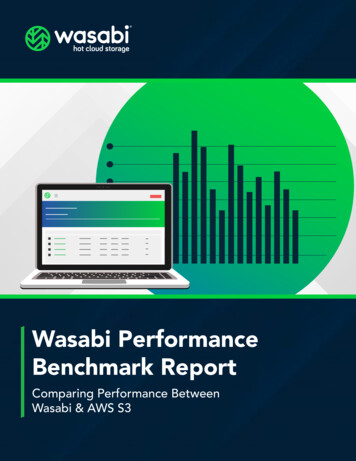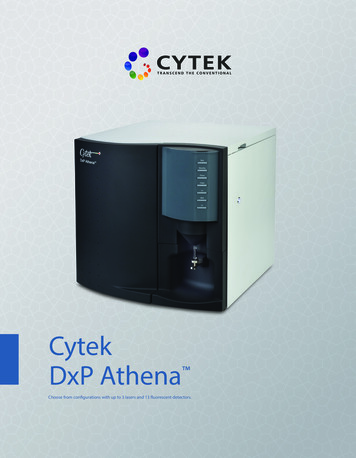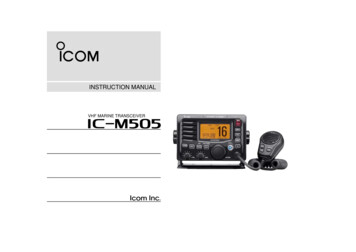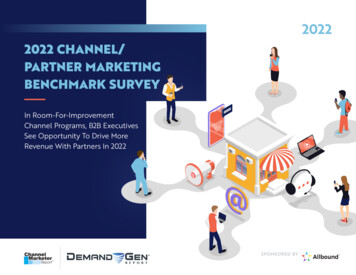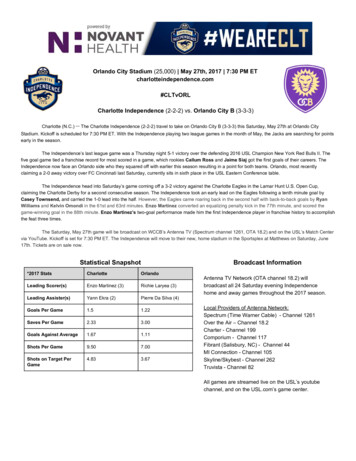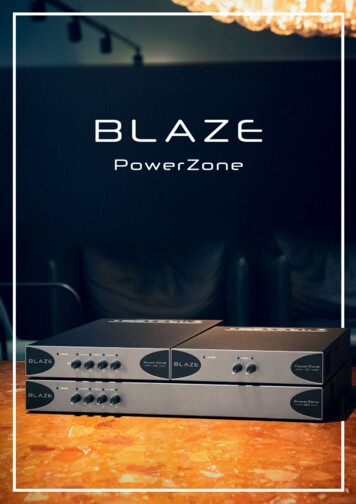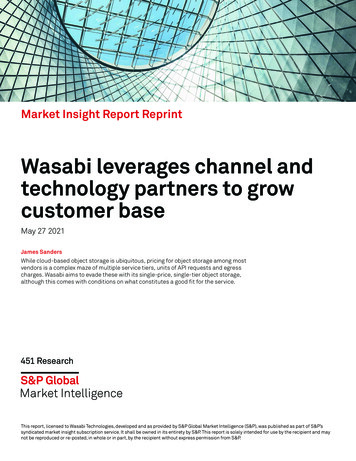
Transcription
Market Insight Report ReprintWasabi leverages channel andtechnology partners to growcustomer baseMay 27 2021James SandersWhile cloud-based object storage is ubiquitous, pricing for object storage among mostvendors is a complex maze of multiple service tiers, units of API requests and egresscharges. Wasabi aims to evade these with its single-price, single-tier object storage,although this comes with conditions on what constitutes a good fit for the service.This report, licensed to Wasabi Technologies, developed and as provided by S&P Global Market Intelligence (S&P), was published as part of S&P’ssyndicated market insight subscription service. It shall be owned in its entirety by S&P. This report is solely intended for use by the recipient and maynot be reproduced or re-posted, in whole or in part, by the recipient without express permission from S&P.
Market Insight Report ReprintIntroductionCloud object storage is quite often a complex affair – the premise of ‘pay money to store data’ is straightforward,though most storage-as-a-service providers differentiate products with multiple service tiers, billed againstthe capacity of storage consumed, units of API requests, and egress charges. Wasabi Technologies eschews thisbusiness model with a single-price, single-tier object storage service.THE 451 TAKEWasabi is making effective use of channel and technology partners to fuel growth, having gainedroughly 8,000 customers over the past 10 months. Positioning object storage as an endpoint for otherproducts – Veeam Backup with Wasabi, for example, has over 2,000 customers alone – is fuelinggrowth in the company. The storage-as-a-utility stance appears to be winning hearts and minds, asthe singular focus of the firm eliminates the specter of future competition with technology partners.The value price point is gaining traction. Wasabi claims to be around a quarter of the price of‘comparable storage from incumbents.’ Typically, attempting to compete on price is something of arace to the bottom – a competitor will inevitably appear to edge others out of the market with a purelyprice-conscious play. This is a somewhat perpendicular point to Wasabi’s strategy. Lacking a computeoption, Wasabi plays in a consciously multicloud world – the firm is not trying to be everything toeveryone.ContextFounded in 2017, Boston-based Wasabi styles itself as a ‘hot cloud storage company’ offering object storagecompatible with Amazon S3 APIs. Founded by CEO David Friend and CTO Jeff Flowers, the company envisions apurposefully multicloud future with Wasabi acting as a utility provider of storage, in much the way networkingand electricity are utilities. Wasabi’s cofounders are experienced in data storage, the duo started personalcomputer backup business Carbonite in 2006. That firm was acquired by OpenText for 805m in 2019. Wasabihas over 150 employees, expanding by roughly 50% since our last coverage.Wasabi’s pricing structure is at the core of its value proposition: pay-as-you-go pricing is set at 5.99 perterabyte per month, with no additional charges for data egress or API requests. The firm offers a discounted,contract-based (Reserved Capacity Storage) option for enterprises with over 50TB of data.Cloud providers’ reliance on egress charges is an encumbrance to cloud storage adoption, with 44% oforganizations that were impacted by egress charges claiming these charges slowed their adoption of cloudstorage, according to 451 Research’s Voice of the Enterprise: Storage, Transformation survey. Further, 31% oforganizations indicated egress charges prevented implementation of a multicloud architecture. Copyright 2021 S&P Global Market Intelligence. All rights reserved.1
Market Insight Report ReprintNegative Consequences of Cloud Storage Egress ChargesSource: 451 Research’s Voice of the Enterprise: Storage, Transformation 2020Which negative consequences have occurred? Please select allthat apply. Base: Respondents impacted by cloud storage egress charges (n 84)FundingWasabi received 112m in a series C round led by Fidelity Management & Research Company in April 2021, withparticipation from existing investors. In May, Wasabi announced an additional 25m in equity capital led byProsperity7 (the diversified growth fund of Aramco Ventures) and Western Digital, providing additional fundingfor global expansion plans and datacenter footprint buildout. In January 2021, Wasabi raised 27.5m in debtfinancing to build out additional infrastructure. The firm has, to date, received a cumulative 275m in fundingacross all rounds.Products and pricingIn essence, Wasabi offers S3-compatible SaaS, at a flat 5.99/TB/month pay-as-you-go price structure (witha 1TB minimum). No alternative tiers are offered for greater or lesser performance characteristics. The firmalso offers Reserved Capacity Storage (RCS) for enterprises with over 50TB of storage. Subscribers on the payas-you-go plan are subject to a minimum 90-day charge for data, with RCS subscribers subject to a 30-dayminimum.Wasabi does not charge for egress, although egress utilization is confined to a ‘reasonable rate’ of access: ifthe total monthly egress is less than or equal to the amount of storage used, Wasabi considers this a ‘good fit.’This comes with a caveat: the terms and conditions note that if the storage use case exceeds this guideline on aregular basis, the company says it reserves the right to limit or suspend service.This limitation is relatively straightforward to architect for, although it makes the service more suitable for databackup and infrequently accessed data – Wasabi is not a stand-in for a content delivery network. Wasabi toutsdata backup and recovery, cloud tier data, archiving, tape-to-cloud, video surveillance storage, global file shareand collaboration, IoT data collection, and data lake use cases.TechnologyAs noted in 451 Research’s initial coverage of Wasabi, the company’s technology stack relies on proprietarylow-level code for management – a proprietary algorithm is designed to extend the lifespan and improveperformance of off-the-shelf drives by minimizing the movement required for the disk head to read or writedata. Likewise, Wasabi utilizes 99% of a physical disk, rather than the 65-70% typical of block-oriented filesystems. Wasabi’s storage architecture is primarily disk-based, with a small amount of flash storage used forcaching/metadata. The firm claims its storage architecture averages out to six times faster than AWS S3. Copyright 2021 S&P Global Market Intelligence. All rights reserved.2
Market Insight Report ReprintWasabi’s API is compatible with the AWS S3 API, making it a suitable drop-in alternative to AWS for objectstorage, subject to egress requirements. For compliance with HIPAA, CJIS, FINRA and other regulatoryrequirements, Wasabi offers immutable buckets, including support for S3 Object Lock, to prevent modificationsto data after upload.Strategy and partnersWasabi is quick to point to channel and technology partners – the firm counts a total of 5,300 channel partnersof which it claims 93% have delivered orders. Channel partners include CDW, SHI, MicroAge and Climb, amongothers. Likewise, technology partners integrating Wasabi support into products or services include Adobe,Altaro, Archiware, Arcserve, Caringo, Comet Backup, Commvault, Falconstor, Flexential, Komprise, Milestone,MSP360, Quest, Rubrik, Tintri, Veeam, Veritas and XenData.CustomersWasabi has grown to over 25,000 customers, adding roughly 8,000 in the 10 months following our previousreport. Marquee customers include May Street, Legendary Pictures, BRUT Media, TITRAFILM and Primestreamas well as educational institutions including more than half of the Ivy Leagues schools, Russell Sage Colleges,Northeast Wisconsin Technical College, and the City of McAllen, Texas.CompetitionNominally, Wasabi’s primary competition comes from the major cloud platforms, AWS, GCP and Azure.Alternative low-cost object storage offerings include Backblaze (which starts at 5.00/TB/month but chargesfor egress and blocks of API transactions), the open source distributed, high-performance object storage serviceMinIO, and enterprise-focused cloud storage firm Zadara.Wasabi also sees itself as competitive with on-premises storage vendors such as NetApp and Dell EMC. Asenterprises continue along cloud transformation plans, there is a window of opportunity for Wasabi to enter intothe equation during refresh cycles.SWOT AnalysisSTRENGTHSWEAKNESSESWasabi’s sole focus on storage makes it a strongpartner rather than a competitor for cloud vendorsthat focus more on diverse computing services.Engineering for multicloud complexity canprompt hesitation among some organizations –infrastructure is cheap compared to developer time.OPPORTUNITIESTHREATSContinued prioritization of its channel salesstrategy is likely to be instrumental as Wasabibuilds out more infrastructure and opens facilitiesin additional regions.AWS, GCP and Azure could stand to cut on-demandpricing or offer more compelling discounts forreserved storage contracts while retaining anadequate margin. Copyright 2021 S&P Global Market Intelligence. All rights reserved.3
CONTACTSThe Americas 1 877 863 1306market.intelligence@spglobal.comEurope, Middle East & Africa 44 20 7176 1234market.intelligence@spglobal.comAsia-Pacific 852 2533 om/marketintelligenceCopyright 2021 by S&P Global Market Intelligence, a division of S&P Global Inc. All rights reserved.These materials have been prepared solely for information purposes based upon information generally available tothe public and from sources believed to be reliable. No content (including index data, ratings, credit-related analysesand data, research, model, software or other application or output therefrom) or any part thereof (Content) may bemodified, reverse engineered, reproduced or distributed in any form by any means, or stored in a database or retrievalsystem, without the prior written permission of S&P Global Market Intelligence or its affiliates (collectively, S&P Global).The Content shall not be used for any unlawful or unauthorized purposes. S&P Global and any third-party providers,(collectively S&P Global Parties) do not guarantee the accuracy, completeness, timeliness or availability of the Content.S&P Global Parties are not responsible for any errors or omissions, regardless of the cause, for the results obtainedfrom the use of the Content. THE CONTENT IS PROVIDED ON “AS IS” BASIS. S&P GLOBAL PARTIES DISCLAIM ANY ANDALL EXPRESS OR IMPLIED WARRANTIES, INCLUDING, BUT NOT LIMITED TO, ANY WARRANTIES OF MERCHANTABILITYOR FITNESS FOR A PARTICULAR PURPOSE OR USE, FREEDOM FROM BUGS, SOFTWARE ERRORS OR DEFECTS, THATTHE CONTENT’S FUNCTIONING WILL BE UNINTERRUPTED OR THAT THE CONTENT WILL OPERATE WITH ANY SOFTWAREOR HARDWARE CONFIGURATION. In no event shall S&P Global Parties be liable to any party for any direct, indirect,incidental, exemplary, compensatory, punitive, special or consequential damages, costs, expenses, legal fees, or losses(including, without limitation, lost income or lost profits and opportunity costs or losses caused by negligence) inconnection with any use of the Content even if advised of the possibility of such damages.S&P Global Market Intelligence’s opinions, quotes and credit-related and other analyses are statements of opinion asof the date they are expressed and not statements of fact or recommendations to purchase, hold, or sell any securitiesor to make any investment decisions, and do not address the suitability of any security. S&P Global Market Intelligencemay provide index data. Direct investment in an index is not possible. Exposure to an asset class represented by anindex is available through investable instruments based on that index. S&P Global Market Intelligence assumes noobligation to update the Content following publication in any form or format. The Content should not be relied on and isnot a substitute for the skill, judgment and experience of the user, its management, employees, advisors and/or clientswhen making investment and other business decisions. S&P Global Market Intelligence does not endorse companies,technologies, products, services, or solutions.S&P Global keeps certain activities of its divisions separate from each other in order to preserve the independenceand objectivity of their respective activities. As a result, certain divisions of S&P Global may have information thatis not available to other S&P Global divisions. S&P Global has established policies and procedures to maintain theconfidentiality of certain non-public information received in connection with each analytical process.S&P Global may receive compensation for its ratings and certain analyses, normally from issuers or underwriters ofsecurities or from obligors. S&P Global reserves the right to disseminate its opinions and analyses. S&P Global’s publicratings and analyses are made available on its Web sites, www.standardandpoors.com (free of charge) and www.ratingsdirect.com (subscription), and may be distributed through other means, including via S&P Global publicationsand third-party redistributors. Additional information about our ratings fees is available atwww.standardandpoors.com/usratingsfees.
Northeast Wisconsin Technical College, and the City of McAllen, Texas. Competition Nominally, Wasabi's primary competition comes from the major cloud platforms, AWS, GCP and Azure. Alternative low-cost object storage offerings include Backblaze (which starts at 5.00/TB/month but charges
